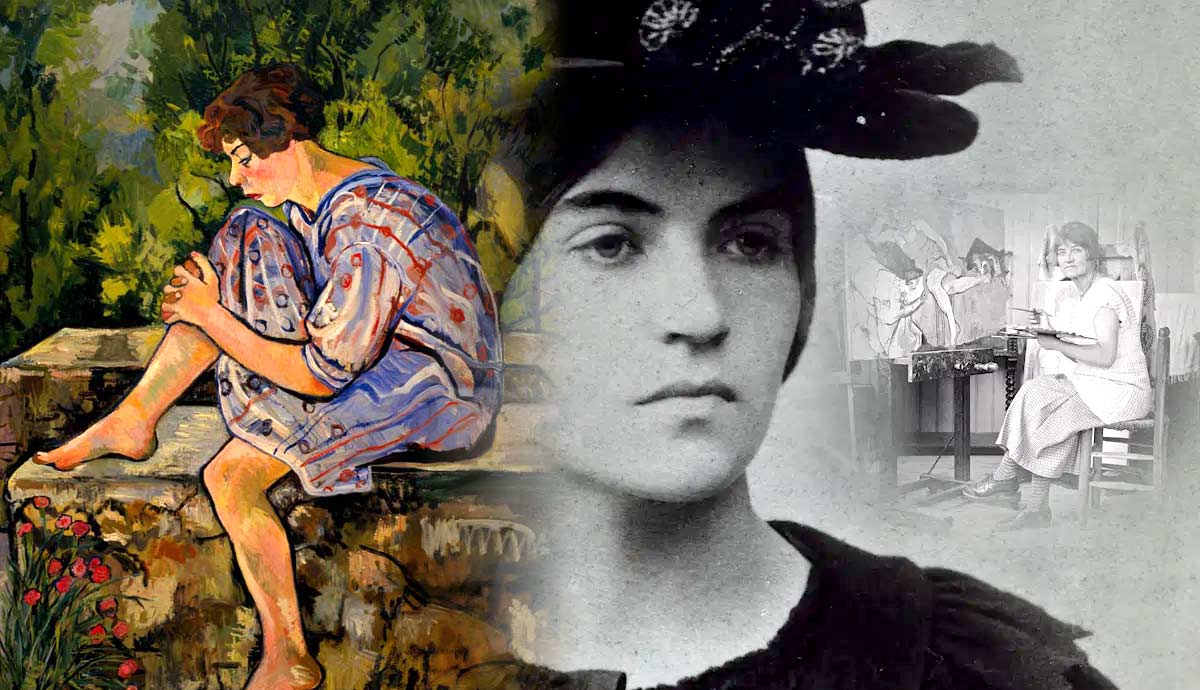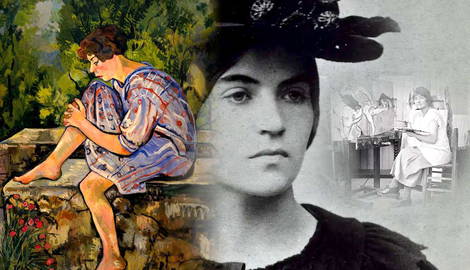
Suzanne Valadon’s life and career story are unique. Born in poverty, she paved her way to the art world not through expensive art classes, but through modeling for famous artists like Renoir and learning directly from them. These experiences shaped her artistic practice, providing her with a unique perspective. A well-known artist in her time, today Valadon is making a comeback as a feminist icon with her bold and empathetic depictions of female nudes.
1. Suzanne Valadon Never Planned on Becoming an Artist

Born to a single mother who was working as a laundress in Montmartre, Suzanne Valadon obviously did not have many chances for a successful career and financial stability. The girl had to start working even before her teenage years to help her mother make ends meet, which made few opportunities for education even less accessible to her. However, Valadon would grow up to be one of the most remarkable women artists of her era.

Prone to mischief from her early years, she wandered through Montmartre surrounded by drunk penniless artists, poets, and sex workers. At the age of fifteen, Valadon became a trapeze acrobat in a well-known Molier circus. Unfortunately, her career as a trapeze artist did not last long. Only six months later Valadon fell and injured her back. Even forty years after the incident Valadon expressed sadness over the trauma that left her unable to perform for the rest of her life.
2. She Worked as a Model

Soon after leaving the circus and recovering, Suzanne Valadon started looking for another occupation. Valadon was interested in art in her early years, drawing on sidewalks with pieces of charcoal. Since she could not afford to pay for art lessons, her mischievous mind found another way to reach her goal of becoming an artist: she became a model. At that time, modeling for artists, especially nude, was considered scandalous and unfit for respectable women. Since Valadon never really tried to live up to societal expectations, the reputation concerns did not bother her.
Valadon gradually started drawing and painting after observing male artists from the model’s position. Over the 10 years of her modeling career, she worked with Pierre-Auguste Renoir, Puvis de Chavannes, Edgar Degas, and Amedeo Modigliani. Many of the artists were also her lovers. According to contemporaries, Valadon had a magical effect on men with her curvy figure and luminous blue eyes.
3. Her Son Grew Up to Be a Painter as Well

In 1883, while still working as a model, Suzanne Valadon gave birth to her son Maurice. Although Maurice was an illegitimate child, in 1891, eight years after his birth, Catalan artist Miquel Utrillo officially recognized Maurice as his own and gave him his last name. However, there is no definitive proof that Utrillos were actually related. Some art historians believe that Renoir was the father of the child, while others lean towards Puvis de Chavannes.

In fact, Suzanne Valadon started drawing a lot more during her pregnancy. Just like his mother, Utrillo also never had any formal artistic training and was mostly taught by Suzanne. Valadon encouraged her son’s painting as a way to cope with his mental illness and alcoholism. That did not help, but Maurice Utrillo managed to combine a successful artistic career with heavy drinking that often disturbed his mother, who was no stranger to that habit herself.
4. She Married Her Son’s Friend

Suzanne Valadon had numerous love affairs, but not a single one of them lasted as long as her relationship with André Utter. Utter was a fellow artist and a close friend of her son Maurice Utrillo. In fact, Maurice was only three years older than his father-in-law. Their family earned the nickname of La Trinité maudite (the cursed trinity) because of their constant alcohol-fueled dramas.

One of the most famous paintings of Suzanne Valadon is a portrait of herself and Utter as Adam and Eve, showing a nude Valadon reaching out for the forbidden fruit. Utter was a less recognized artist in comparison with Valadon and Utrillo, thus he decided to set aside his artistic pride and become a manager of his wife and his son-in-law. The couple spent more than 30 years together. They officially got a divorce in 1934, but they kept seeing each other until Valadon’s death four years later.
5. She Had a Remarkable Yet Chaotic Personality

Valadon was known for her remarkable and eccentric character. Her behavior was far off from the respectable standards of the time. She drank heavily, smoked a pipe, and frequently engaged in fights and brawls.
Her personality had a softer side, but even in her kindness, Valadon was quite unhinged and chaotic. She once picked up several dozen of random kids from the streets of Paris just to take them to a circus performance. She also had a soft spot for cats. Swarms of felines of all patterns and sizes roamed freely in her studio. She had a favorite cat too, an orange tabby named Raminou that appeared on her canvas numerous times. As a model, Raminou had a career almost as remarkable as his owner’s!
6. She Painted the Working Class

Modeling as an occupation was a thing predominantly dedicated to working-class women. Other women artists of the period, such as Berthe Morisot and Mary Cassat were frequently working with models, especially while painting scenes of mothers and children. At that time, working-class mothers were believed to be more affectionate and natural around their children in comparison to higher-class women, who could not afford to express that much emotion due to their upbringing.

However, when it came to the actual depictions, lower-class people were considered unworthy, mundane, and unrelatable to the public who was able to appreciate these paintings. Thus, although many laundresses, maids, and sex workers posed for paintings, the artists usually stripped them of their class signifiers, painting expensive clothing and jewelry to make them look respectable. But this was never the case with Suzanne Valadon. Aware of her roots and upbringing, she deliberately painted working women as they were, with simple or no clothes, with their bodies marked with hard work and childbirth.
7. Her Works Show Great Examples of The Female Gaze

Valadon’s modeling experience was a factor that made her artworks different from those of other women artists of the period. Consciously or not, her modeling career shaped her artistic identity. Being a model herself, she knew what it was like to have her identity erased and repainted.
Her female nudes show a stark contrast to the works of other artists of her time period. A body painted by Valadon never shows an idealized fantasy or a fetish. It is a real body of a real woman that shows signs of age and hard labor. The painted woman may be taking a bath or resting on a couch, but she is never shown as a passive figure for someone’s visual pleasure. Valadon’s works frequently dealt with the topic of age and time passing.
8. She Painted Numerous Self-Portraits

Self-portraiture is another aspect crucial to Valadon’s artistic career. The artist frequently painted self-portraits and included herself in the paintings of her family members. The act of painting a self-portrait can be read as the ultimate level of self-acceptance. The person behind the canvas is confident enough to deem themselves worthy of depiction. In a way, this is the most direct link an artist can make between their personality and art and that link is particularly important in the cases of women artists.
Suzanne Valadon was never too shy or unsure of herself. She started painting self-portraits at the beginning of her career. She was also very open about signs of aging. Her late self-portraits revealed her aging face and body with little to no visible attempts to cling to her fleeting youth. Instead, she embraced her age.
9. Suzanne Valadon Was Underestimated For Years

Thanks to her talent and her involvement in art circles of her time, Valadon and her son were able to connect with art dealers and collectors rather easily. But, just like in the cases of many other women artists, Valadon’s artistic legacy was eventually swept under the carpet and nearly forgotten after she passed away in 1938. Her name kept reappearing in exhibition catalogs and art history books, but she was mostly mentioned as a model or as the mother of Maurice Utrillo.

While the French cultural institutions were showing Valadon’s work during her lifetime and in the years following her death, her first public show in the United States happened in 2021. However, Suzanne Valadon’s work has recently been interpreted through the perspectives of feminist art history due to her personal experience as a model and her unique rendering of the female body.










